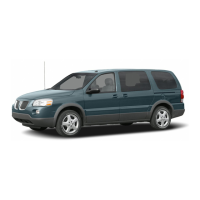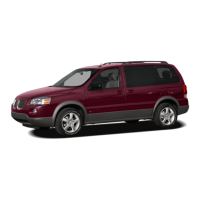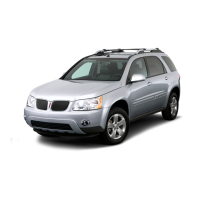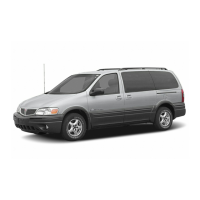
Do you have a question about the Pontiac 2006 Montana SV6 and is the answer not in the manual?
| Brand | Pontiac |
|---|---|
| Model | 2006 Montana SV6 |
| Category | Automobile |
| Language | English |
Details on manual and power front seat adjustments and features like heating.
Comprehensive guide on safety belt usage, proper wearing, and related systems.
Instructions and safety information for using child restraint systems.
Explanation of airbag operation, location, and safety precautions.
Emphasizes the importance and universal use of safety belts for all occupants.
Addresses common questions regarding safety belt use, especially with airbags.
Instructions on adjusting the shoulder belt height for optimal safety.
Guidance on proper safety belt usage for pregnant occupants.
Explanation of the safety belt pretensioner system and its function.
Guidance for older children who have outgrown booster seats.
Safety advice for infants and young children requiring restraints.
Details on the various types of child restraints available for purchase.
Description of an infant car bed as an infant restraint system.
Description of a rear-facing infant seat and its harness system.
Description of forward-facing child seats with harnesses and shields.
Explanation of booster seats for improving safety belt fit.
General guidance on the correct usage of child restraint systems.
Instructions on how to properly secure child restraints in the vehicle.
Describes the vehicle's lower anchors used for LATCH system installation.
Explains the vehicle's top tether anchors for child restraint security.
How to secure a child restraint in rear seat positions, with or without LATCH.
Guidance on securing child restraints in the front passenger seat, with airbag considerations.
Identifies the locations of the driver's and passenger's frontal and side airbags.
Explains the conditions and crash speeds that trigger airbag deployment.
Details the factors and sensors that cause an airbag to inflate.
Explains how airbags work with seat belts to restrain occupants during a crash.
Explains the system that detects occupants to control airbag deployment.
Details on locking and unlocking vehicle doors and related features.
Explains the vehicle's anti-theft features and alarm system.
Detailed instructions on using the remote keyless entry transmitter.
Operation of the power door lock switches on the doors.
Identifying the different PSD switches located on the overhead console.
Detailed instructions on how to operate power sliding doors.
Details on the theft-deterrent alarm system and its operation.
How the PASS-Key® III system operates and interacts with the key.
Explanation of the different key positions in the ignition switch.
Step-by-step instructions for starting the vehicle's engine.
Proper procedure for shifting into park and securing the vehicle.
How to shift the lever out of park, including considerations for ignition lock.
Details on available OnStar® plans and services.
How to operate the universal home remote system.
Steps to program the universal home remote transmitter.
A general overview of the instrument panel layout.
Operation of the turn signal and multifunction lever.
How to switch between high and low beam headlamps.
Operation of windshield wipers, including speed and delay settings.
How to use the windshield washer system.
Information on the cruise control system, including cautions for use.
Step-by-step guide to setting the cruise control speed.
How to resume a previously set cruise control speed.
Controls for operating the vehicle's exterior lamps.
Functionality and operation of DRL and automatic headlamp systems.
Explanation of the URPA system for parking assistance.
Details on how the URPA system detects objects and provides feedback.
How to control heating, cooling, and ventilation.
Operation of the climate control system for vehicle comfort.
Explains the various warning lights and gauges on the instrument panel.
Overview of the instrument panel cluster and its indicators.
What the airbag readiness light indicates and when to service the system.
Explains the indicator for the passenger airbag status.
How to check safety belts and airbag covers for damage.
What the "Check Engine" light signifies and what to do.
What the oil pressure light indicates and necessary actions.
Overview of the DIC system for displaying vehicle information and messages.
How to navigate and view information on the DIC display.
How the oil life system estimates remaining oil life and when to change oil.
Explanation of various warning messages displayed on the DIC.
Indicates when engine oil service is required.
Indicates a problem with the charging system.
Warning for engine overheating and recommended actions.
Warning for low brake fluid level.
Critical warning for low engine oil pressure, requiring immediate stop.
Warning for overheated engine, advising to stop safely.
Indicates a problem with the anti-lock brake system.
Indicates a problem with the airbag system.
Indicates a detected problem with the brake system.
Indicates a problem with the StabiliTrak® system.
Indicates a problem with the traction control system.
Operation and features of the radio with CD player.
Instructions for playing CDs in the single CD player.
Guidelines for using MP3 CDs, including file format and burning.
Specific requirements for MP3 files on CDs.
Information about the RSE system including DVD player and video screen.
Operation and compatibility of the DVD player.
A chart of common problems and recommended solutions for the audio/video system.
General advice on safe driving practices.
Importance and techniques of defensive driving.
Dangers and effects of drinking and driving.
How brakes, steering, and accelerator control the vehicle.
Explanation of braking action, perception, and reaction time.
How the ABS system prevents braking skids.
How the TCS system limits wheel spin.
Explanation of the StabiliTrak® system for directional control.
How to control the vehicle's direction.
What happens when control systems lack tire friction.
How drivers can lose control and avoid skids.
How rain and wet roads affect driving and precautions to take.
Precautions for driving on slippery snow and ice surfaces.
Information on vehicle weight capacity and proper loading.
Information on the vehicle certification and tire label.
How to calculate the correct load limit for the vehicle.
General information and advice on towing.
How to have a disabled vehicle towed.
Important considerations and steps for towing a trailer.
Important points to consider before deciding to tow a trailer.
How trailer weight affects vehicle capacity and handling.
Safety precautions and tips for driving with a trailer attached.
How to pass safely when towing a trailer.
Specific maintenance needs for vehicles used for towing.
Importance of dealer service and genuine GM parts.
Information on using the correct fuel for vehicle maintenance.
Safety precautions and instructions for refueling the vehicle.
General advice and safety warnings for checking under the hood.
Identification of components in the engine compartment.
Information on engine oil, including checking the level.
Guidance on selecting the correct engine oil type and viscosity.
Explanation of the system that indicates when to change engine oil.
Steps to reset the engine oil life system after an oil change.
Information about the engine coolant and cooling system.
What to do if the engine overheats and safety precautions.
Information on brake fluid and brake wear indicators.
Safe procedures for jump starting a vehicle with a dead battery.
Lubricant checks for AWD systems.
Instructions for replacing windshield wiper blades.
What to do if a tire blows out while driving.
Step-by-step instructions for safely changing a flat tire.
Information on tire maintenance, safety, and when to replace tires.
Approximate capacities and specifications in English and metric units.
Importance of keeping engine oil at proper level and changing as recommended.
Importance of following maintenance schedules for vehicle condition and warranty.
How proper maintenance contributes to vehicle condition and environmental protection.
Guidance on how to use the maintenance schedule based on driving habits.
Explanation of Maintenance I and Maintenance II schedules based on service messages.
Checks and services owners should perform at specified intervals.
How to check the engine oil level and add oil if necessary.
List of recommended fluids and lubricants, with part numbers and specifications.
Overview of customer assistance programs and information resources.
Steps to follow if concerns are not resolved by the dealership.
Overview of roadside assistance services available to Pontiac owners.
How to report safety defects to the US and Canadian governments and GM.












